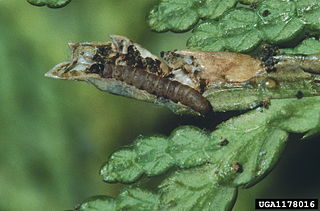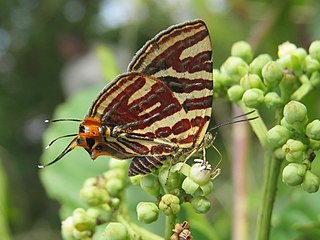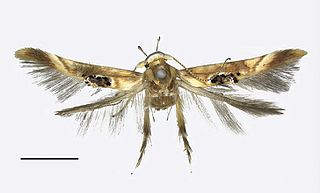
The red underwing is a moth of the family Erebidae. The species was first described by Carl Linnaeus in his 1767 12th edition of Systema Naturae.

Apamea crenata, known as the clouded-bordered brindle, is a moth in the family Noctuidae. It is distributed throughout the Palearctic realm. In the North it crosses the Arctic Circle, in the Mediterranean it is found only in cool locations and mountains avoiding very hot areas. In the Alps, it rises to an altitude of about 2000 metres.

Appias lalage, the spot puffin, is a small butterfly of the family Pieridae, that is, the yellows and whites, which is found in India, Indochina and Hainan.

Deudorix epijarbas, the cornelian or hairy line blue, is a species of lycaenid or blue butterfly found in south and southeast Asia from India to Fiji, including the Philippines, and also the tropical coast of Queensland in Australia. The species was first described by Frederic Moore in 1857.

Hydraecia micacea, the rosy rustic, is a moth of the family Noctuoidea. It is found across the Palearctic realm from Ireland to Siberia. It reaches Japan and is introduced to eastern USA, Quebec and Ottawa.

Catocala electa, the rosy underwing, is a moth of the family Erebidae. The species was first described by Karl Friedrich Vieweg in 1790. It can be found in Europe and Asia.

Mesapamea secalis, the common rustic, is a moth of the family Noctuidae. The species was first described by Carl Linnaeus in his 1758 10th edition of Systema Naturae. It is found in Europe, north-west Africa, Turkey and northern Iran.

Jodia croceago, the orange upperwing, is a moth of the family Noctuidae. The species was first described by Michael Denis and Ignaz Schiffermüller in 1775. It is found in southern and central Europe, to the north up to the southern half of England and Wales. According to Warren. W. in Seitz, A. Ed., 1914 also in Algeria, Asia Minor, and Armenia.

Coleotechnites thujaella is a moth of the family Gelechiidae. It is found in the north-eastern parts of the United States, as well as Canada.

The ponderosa pine needleminer is a moth of the family Gelechiidae. It is found in the United States, where it has been recorded from Colorado.

The double-spot brocade is a species of moth of the family Noctuidae. It is found in most of Europe, in Turkey and the west of Iran. In Anatolia it is represented by the subspecies Meganephria bimaculosa pontica.

Cigaritis lohita, the long-banded silverline, is a species of lycaenid or blue butterfly.
Boryzops purissima is a species of moth of the family Erebidae. It is found in the southern United States, where it has been recorded from Florida and Texas, as well as in Veracruz in Mexico, Costa Rica and Jamaica.
Syllepte cometa is a moth in the family Crambidae. It was described by William Warren in 1896. It is found in Assam, India.
Coleotechnites coniferella is a moth of the family Gelechiidae. It is found in North America, where it has been recorded from California, Illinois, Indiana, Maryland, Massachusetts, Michigan, Minnesota, Mississippi, New York, Ontario, Washington and Wisconsin.
Scrobipalpula artemisiella, the thyme moth, is a moth in the family Gelechiidae. It was described by William D. Kearfott in 1903. It is found in the United States, where it has been recorded from California, Arizona, Illinois, Maine, Maryland and Ohio.

Hieromantis puerensis is a moth of the Stathmopodidae family. It is found in Yunnan, China.

Teliphasa similalbifusa is a species of moth of the family Pyralidae. It is found in China (Guangxi).
Psittacastis stigmaphylli is a moth in the family Depressariidae. It was described by Lord Walsingham in 1912. It is found on Jamaica.
Hypertropha thesaurella is a moth in the family Depressariidae. It was described by Edward Meyrick in 1880. It is found in Australia, where it has been recorded from Queensland and New South Wales.













